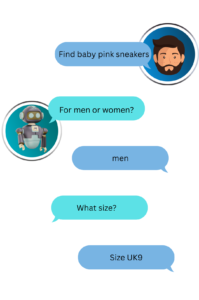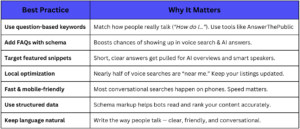Conversational Search Optimization: How to Rank for Natural Language Queries in 2025


Ever asked your phone, “Where’s the best pizza near me right now?” Or told Alexa, “Book me a yoga class tomorrow morning”?
Congrats — you just did a conversational search.
In 2025, this is no longer just about voice assistants — it’s about how AI chatbots, Google’s “AI Mode,” and new answer engines reshape everything we know about SEO.
If your content doesn’t match the way people naturally ask questions, it’s easy to get pushed aside, no matter how great the information is.
In this guide, you’ll learn:
Let’s get into it.
Conversational search is when people use natural, full-sentence questions instead of short, robotic keyword phrases.
In the past, a typical search might look like: “best cheap restaurant open now.”
Today, it sounds more like: “Where can I find a good, affordable place to eat that’s open late tonight?”
Real-World Example:
A user shopping online might say, “Find baby pink sneakers,” and the system responds with clarifying questions like, “For men or women?” and “What size?”—guiding the user step-by-step to the most relevant results, just like a human assistant.

Why the shift?
Here’s why you can’t ignore this:
Today, search feels more like a real conversation — fast, human, and intuitive. It delivers accurate, personalized answers in any language, keeps people engaged, drives conversions, and cuts support costs.
Modern search engines — like Google’s AI Mode, ChatGPT, and other answer engines — don’t just pick out keywords. They actually understand what people mean when they talk naturally. Here’s how:
1. Natural Language Processing (NLP)
This is how search engines read full sentences, the way we do. Tools like BERT and MUM break down your question, figure out the meaning behind each word, and understand how they connect. For example, they know the difference between “Apple the fruit” and “Apple the company.”
2. Entity Understanding
Search engines map out how people, brands, places, and things relate to each other — like a giant mind map. So when you search “best Italian restaurants near me,” they know you’re looking for local businesses, not recipes or travel guides about Italy.
3. User Intent
It’s not about matching every word exactly — it’s about solving what you actually want. If you type “How do I fix a flat tire?”, the search engine knows you probably want a simple step-by-step guide, not just a definition of “flat tire.”
So today, ranking on Google isn’t about stuffing in the right keywords over and over. It’s about giving people clear, natural answers that match what they’re really asking — in the same way you’d help a friend.
Best Practices for Conversational Search (the Must-Do Basics)
These tried-and-true steps help you show up when people ask real questions:
1. Use long-tail, question-based keywords
People don’t search “bike repair tips” — they ask “How do I fix my bike chain?” Use tools like AnswerThePublic or AlsoAsked to find real questions people are asking.
2. Add clear FAQ sections
FAQs make it easy for Google to pull direct answers. Use the FAQ schema so your answers stand out in search results and voice responses.
3. Aim for featured snippets
Keep your answers short and clear near the top of your page. That’s what voice assistants and AI overviews grab first.
4. Optimize for local searches
Almost half of voice searches are local. Keep your Google Business Profile up to date so you show up when someone says “near me.”
5. Keep your site fast & mobile-friendly
Voice and AI searches mostly happen on phones. If your site is slow or clunky, you’re out of the game.
6. Use structured data
Schema markup helps search engines understand what your content really means, giving you an edge for rich results.
7. Write like you talk
Ditch the keyword stuffing. Use natural language, short sentences, and clear answers — just like you’d explain it to a friend.
Here’s a quick table to keep these best practices clear and easy to follow:

Bookmark this checklist — and make sure your next blog or landing page follows these simple rules to rank for real, human questions.
Now let’s get to the 2025 edge. Here’s how to go beyond the basics:
AEO (Answer Engine Optimization) is the new SEO.
Google’s AI Mode doesn’t just show links — it pulls snippets and answers. So:
The new AI ranking is entity-first. Google and AI bots link related facts about your brand.
So:
AI uses sentiment to judge if your answer is positive, negative, or neutral.
So:
Most sites stick to a single FAQ page.
In 2025, smart brands use modular FAQs — dynamic blocks you reuse across product pages, blog posts, and landing pages.
Bonus: You stay consistent, cover more long-tail questions, and feed AI engines fresh answers.
Google’s MUM model connects text, images, and video.
AI prefers trusted, engaging sources.
When your content shows up in AI Mode, your trust signals matter:
Look beyond rankings. Measure:
How often do you earn featured snippets or AI snippets
Voice search traffic in Google Search Console
“Zero-click” impressions (if people see your answer without clicking)
Use tools like:
Conversational search is no longer optional.
It’s the bridge between your audience and your business, through voice assistants, AI chatbots, and Google’s answer engines.
Master the basics. Adopt the advanced strategies.
Start answering real questions the way real people talk. And don’t just chase keywords — build trust, clarity, and context that AI can’t ignore.